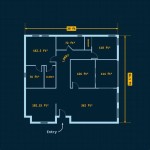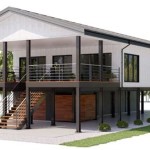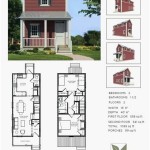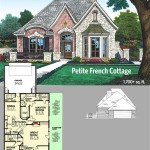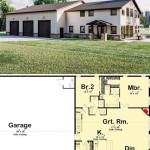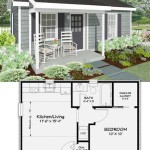Creating a Floor Plan of Your Dream House
Developing a floor plan for a dream house is a significant undertaking, requiring careful consideration of numerous factors, from lifestyle needs to aesthetic preferences and regulatory compliance. A well-crafted floor plan serves as the blueprint for realizing the desired living space, guiding contractors, interior designers, and other professionals involved in the construction process. It visually represents the layout, dimensions, and spatial relationships of rooms, hallways, and other architectural features, ensuring a cohesive and functional design.
The process of creating a floor plan can be approached in various ways, depending on the individual's skill set, available resources, and desired level of detail. Options range from sketching by hand to utilizing sophisticated computer-aided design (CAD) software. Regardless of the chosen method, a systematic approach is crucial to ensure accuracy and completeness. This article explores the key steps and considerations involved in creating a floor plan for a dream house, providing a comprehensive overview of the process.
Defining Needs and Priorities
Before embarking on the actual drafting of the floor plan, it is imperative to thoroughly define the needs and priorities that will shape the design. This involves a comprehensive assessment of the intended occupants' lifestyle, habits, and preferences. Factors such as family size, work-from-home arrangements, hobbies, and entertainment preferences all play a crucial role in determining the size, layout, and functionality of the various rooms and spaces within the house.
A crucial step is to create a detailed list of all the desired rooms and spaces, including their intended purpose and approximate size. This list should encompass not only essential spaces like bedrooms, bathrooms, and living areas but also specialized spaces such as home offices, gyms, libraries, or hobby rooms. Careful consideration should be given to the size and layout of each room, taking into account the intended furniture placement, traffic flow, and natural light considerations. For example, a home office may require ample desk space, storage solutions, and minimized distractions, while a living room may prioritize comfortable seating arrangements and a focal point such as a fireplace or entertainment center.
Beyond the individual rooms, the overall flow and connectivity between different spaces should also be carefully considered. Open-concept designs, where living, dining, and kitchen areas seamlessly blend together, are popular for their spaciousness and sociability. However, they may not be suitable for individuals who value privacy or prefer distinct zones for different activities. Conversely, traditional floor plans with clearly defined rooms offer greater privacy and separation but may feel more compartmentalized.
Accessibility is another critical factor to consider, particularly for individuals with mobility limitations or those planning to age in place. Incorporating universal design principles, such as wider doorways, ramps, and accessible bathrooms, can ensure that the house remains functional and comfortable for all occupants throughout their lives. Prioritizing energy efficiency and sustainability is also essential, considering factors such as insulation, window placement, and renewable energy sources. Thoughtful planning at this stage can significantly impact the long-term comfort, functionality, and value of the house.
Sketching and Conceptualizing the Layout
Once the needs and priorities have been clearly defined, the next step involves sketching and conceptualizing the layout of the floor plan. This is an iterative process that involves experimenting with different arrangements of rooms and spaces until a satisfactory design is achieved. It is often helpful to start with a rough sketch of the overall footprint of the house, taking into account the dimensions of the lot, setback requirements, and any other zoning restrictions.
With the overall footprint established, the next step is to start arranging the rooms and spaces within that framework. It is helpful to consider the relationships between different rooms and how they will connect to each other. For example, the kitchen should ideally be located near the dining area and the garage for convenient grocery unloading. The bedrooms should be located away from noisy areas such as the living room or kitchen to ensure privacy and restful sleep.
During the sketching phase, it is important to consider the placement of windows and doors, as they significantly impact the natural light and ventilation within the house. Orienting windows towards the south can maximize solar gain in winter, while strategically placed windows can capture prevailing breezes for natural cooling in summer. The size and placement of windows should also be carefully considered to ensure privacy and avoid glare.
The sketching process is inherently flexible and allows for experimentation and adjustment. Do not hesitate to try different layouts and arrangements until a design that meets the defined needs and priorities is achieved. It can be beneficial to create multiple sketches, each representing a different concept or approach, and then compare and contrast them to identify the strengths and weaknesses of each. This iterative process helps refine the design and ensure that the final floor plan is both functional and aesthetically pleasing.
Utilizing Floor Plan Software
While hand-drawn sketches can be useful for initial conceptualization, utilizing floor plan software offers distinct advantages for creating accurate and detailed representations of the design. Various software options are available, ranging from free online tools to professional-grade CAD programs. The choice of software depends on the individual's skill level, budget, and desired level of detail.
Free online floor plan tools typically offer a user-friendly interface and basic features for drawing walls, adding doors and windows, and arranging furniture. These tools are suitable for creating simple floor plans and visualizing basic layouts. However, they may lack the advanced features and precision required for professional-quality drawings.
Professional-grade CAD software, on the other hand, provides a comprehensive suite of tools for creating highly detailed and accurate floor plans. These programs allow for precise measurements, layering, and the creation of 3D models. They also offer features such as automatic dimensioning, material takeoff, and building information modeling (BIM) capabilities. However, CAD software typically requires specialized training and can be expensive.
Regardless of the chosen software, it is essential to learn the basic functionalities and features before attempting to create the floor plan. Most software programs offer tutorials and online help resources to guide users through the process. When drawing the floor plan, it is crucial to maintain accuracy and consistency in measurements and dimensions. Utilize the software's grid and snap features to ensure that walls are aligned and that doors and windows are placed correctly. Pay attention to the thickness of walls, the size of doors and windows, and the placement of fixtures and appliances.
Once the basic floor plan is drawn, the software can be used to add details such as furniture, fixtures, and finishes. This allows for visualizing the space and how it will function in practice. The software can also be used to generate 3D models of the house, providing a realistic representation of the final product. By utilizing floor plan software effectively, it is possible to create a detailed and accurate blueprint for the dream house, which can then be used for construction, interior design, and other purposes.
In summary, creating a floor plan of a dream house is a multifaceted process. Meticulous planning, thoughtful conceptualization, and precise execution are paramount. By first defining the needs and priorities of the occupants, then sketching and conceptualizing the layout, and finally utilizing floor plan software to create a detailed and accurate representation, individuals can realize their vision of the perfect living space.

Pin On Design

Best 2 Bedroom Single Floor Plans For Your Dream Home Pictures Easy Tips Design Plan House

Create A Floorplan To Your Dream House In 24 Hours By Wowowen19 Fiverr

Build Your Dream House Inspired By This Modern Design Cool Concepts

My Dream House

This Contemporary Two Y House Will Make You Want To Build Your Dream Tomorrow Pinoy Plans

36x37 House Plans For Your Dream Carriage Craftsman Bungalow

Build Your Dream House Inspired By This Modern Design Cool Concepts

How To Read The Blueprint Of Your Dream Home

Design Your Dream House Plan Cast And Maintanence Is Very Simple Method For Modern
Related Posts


